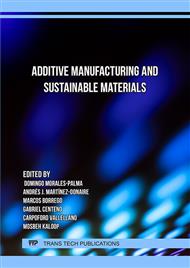p.3
p.13
p.21
p.31
p.41
p.49
p.57
p.67
p.77
Desiccant Dehumidification System Developed Using Additive Manufacturing and Biodegradable Materials
Abstract:
Traditional dehumidification equipment is based on vapour compression units. However, they depend mainly on electrical energy and use polluting gases. An alternative to this equipment is desiccant dehumidification systems, which is based on adsorbent materials. These desiccant systems are an efficient way of removing moisture from the air in buildings with high latent loads. This work presents a new way to manufacture fixed-bed desiccant elements that can remove moisture from an air flow. The desiccant element is obtained by material extrusion-based additive manufacturing (fused filament fabrication or FFF). This technology is cost-effective and provides a precision and finish suitable for the intended use. The filament used is Pine, consisting of an easy printable thermoplastic matrix (polylactic acid, PLA, 80 wt%) and a filler based on pine wood powder (20 wt%). This composite material reached a water absorption capacity of 11.5 %. The experimental results of the desiccant air unit demonstrated high dehumidification capacity, up to 39 mg/s, for a regeneration air temperature of 50 °C. The volumetric adsorption rate was also high, up to 30 g/s·m3, for low pressure drop values, below 522 Pa. The proposed method allows the customised, on-demand and just-in-time manufacturing of air dehumidification systems based on the use of biodegradable desiccant materials of organic origin. Such solutions contribute to the circular economy promoted by The United Nations in the Sustainable Development Goals.
Info:
Periodical:
Pages:
41-47
Citation:
Online since:
October 2023
Authors:
Price:
Сopyright:
© 2023 Trans Tech Publications Ltd. All Rights Reserved
Share:
Citation:



